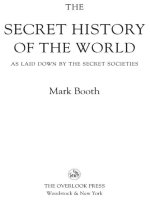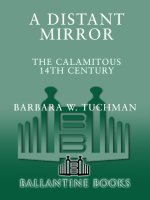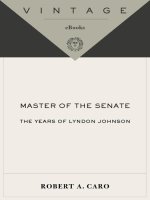Jack weatherford the secret history of the mong ens (v5 0)
Bạn đang xem bản rút gọn của tài liệu. Xem và tải ngay bản đầy đủ của tài liệu tại đây (1.53 MB, 233 trang )
ALSO BY
JACK WEATHERFORD
Genghis Khan and the Making of the Modern World
The History of Money
Savages and Civilization:
Who Will Survive?
Native Roots:
How the Indians Enriched America
Indian Givers:
How the Indians of the Americas Transformed the World
Tribes on the Hill:
The United States Congress—Rituals and Realities
May the Golden Light of the Eternal Blue Sky
forever bless the mothers and the daughters
of the Great Mongol Nation
CONTENTS
Map of the Mongol Empire (1206–1368)
INTRODUCTION
The Missing Chapter
PART I
Tiger Queens of the Silk Route 1206–1241
1 It Takes a Hero
2 The Growling Dragon and the Dancing Peacock
3 Our Daughters Are Our Shields
4 Queens at War and Commerce
PART II
The Shattered Jade Realm 1242–1470
5 War Against Women
6 Granddaughters of Resistance
7 The Rabbit Demon’s Revenge
8 Daughter of the Yellow Dragon
9 The Falling Prince and the Rising Queen
PART III
Wolf Mother 1470–1509
10 The White Road of the Warrior Widow
11 Winning the War and Raising a Husband
12 Facing the Wall
13 Her Jade Realm Restored
EPILOGUE
The Secrets of History
SELECTED BIBLIOGRAPHY
A NOTE ON TRANSLITERATION
NOTES
ACKNOWLEDGMENTS
INTRODUCTION
The Missing Chapter
O
, an unidenti ed hand clumsily cut away
part of the text from the most politically sensitive section of The Secret History
of the Mongols. The censored portion recorded words spoken by Genghis Khan
in the summer of 1206 at the moment he created the Mongol Empire and gave shape
to the government that would dominate the world for the next 150 years. Through
oversight or malice, the censor left a single short sentence of the mutilated text that
hinted at what had been removed: “Let us reward our female offspring.”
In the preceding section of the text, Genghis Khan bestowed o ces, titles,
territories, and vassals upon his sons, brothers, and other men according to their
ability and contribution to his rise to power. But at the moment where the text
reported that he turned to the assembly to announce the achievements and rewards of
his daughters, the unknown hand struck his words from the record. The censor, or
possibly a scribe copying the newly altered text, wrote the same short nal sentence
twice. Perhaps the copyist was careless in repeating it, or perhaps the censor
deliberately sought to emphasize what was missing or even to taunt future
generations with the mystery of what had been slashed away.
More than a mere history, the document known as The Secret History of the Mongols
recorded the words of Genghis Khan throughout his life as he founded the Mongol
nation, gave his people their basic laws, organized the administration, and delegated
powers. It served as the biography of a tribe and its leader as well as the national
charter or constitution of the nation that grew into a world empire. Only the most
important members of the royal family had access to the manuscript, and therefore it
acquired its name.
The Secret History provides an up-close and personal view of the private life of a
ruling family that is unlike any other dynastic narrative. The text records the details
of conversations in bed between husband and wife; of routine family problems as well
as arguments over who had sex with whom; and expressions of the deepest fears and
desires of a family who could not have known that they would become important
actors in world history. Many episodes and characterizations, particularly those
regarding Genghis Khan’s early life, are un attering. It was not written by
sycophantic followers currying favor, but by an anonymous voice dedicated to
preserving the true history of one of the world’s most remarkable men and the empire
he founded. That did not mean that the history was available to just anyone, however.
N AN UNKNOWN DAY LATE IN THE THIRTEENTH CENTURY
The Mongols operated possibly the most secretive government in history. They
preserved few records, and those were written in the Mongolian language, which their
conquered subjects were not allowed to learn. While Mongol khans gave away jewels
and treasures with little evidence of covetousness, they locked their documents inside
the treasury and kept them closely guarded. As Persian chronicler Rashid al-Din wrote
in the thirteenth century: “From age to age, they have kept their true history in
Mongolian expression and script, unorganized and disarranged, chapter by chapter,
scattered in treasuries, hidden from the gaze of strangers and specialists, and no one
was allowed access to learn of it.” Both the secrecy of the records and the apparent
chaos in which they were kept served the purposes of the rulers. With such an
unorganized history, the person who controlled the treasury of documents could pick
and choose among the papers and hide or release parts as served some political
agenda of the moment. If a leader needed to discredit a rival or nd an excuse to
punish someone, there was always some piece of incriminating evidence that could be
pulled from the treasury. Following the example of Genghis Khan, the early Mongol
rulers clearly recognized that knowledge constituted their most potent weapon, and
controlling the flow of information served as their organizing principle.
Genghis Khan sired four self-indulgent sons who proved good at drinking, mediocre
in ghting, and poor at everything else; yet their names live on despite the damage
they did to their father’s empire. Although Genghis Khan recognized the superior
leadership abilities of his daughters and left them strategically important parts of his
empire, today we cannot even be certain how many daughters he had. In their
lifetime they could not be ignored, but when they left the scene, history closed the
door behind them and let the dust of centuries cover their tracks. Those Mongol
queens were too unusual, too di cult to understand or explain. It seemed more
convenient just to erase them.
Around the world, the in uential dynasties of history exhibit a certain uniformity in
their quest for power, and they distinguish themselves from one another primarily
through personal foibles, dietary preferences, sexual proclivities, spiritual callings,
and other strange twists of character. But none followed a destiny quite like that of
the female heirs of Genghis Khan. As in every dynasty, some rank as heroes, others as
villains, and most as some combination of the two.
Rashid al-Din wrote that “there are many stories about these daughters.” Yet those
stories disappeared. We may never nd de nitive accounts for all seven or eight of
Genghis Khan’s daughters, but we can reassemble the stories of most of them. Through
the generations, his female heirs sometimes ruled, and sometimes they contested the
rule of their brothers and male cousins. Never before or since have women exercised
so much power over so many people and ruled so much territory for as long as these
women did.
References to Genghis Khan’s daughters have come down to us in a jumble of names
and titles with a stupefying array of spellings, according to how each sounded to the
Chinese, Persians, Armenians, Russians, Turks, or Italians who wrote their stories.
Each source di ers on the number of daughters. The Secret History identi es eight
sons-in-law for Genghis Khan and his wife Borte in the pivotal year 1206, and it
further identi es each of them as a commander of a thousand troops. The list of sonsin-law is longer than the list of daughters, due in part to multiple marriages and also
to the e orts of more distant relatives by marriage to raise their status and apparent
closeness to Genghis Khan in the official record.
Through the generations, Mongol chroniclers and scholars dropped the names of
Genghis Khan’s daughters one by one from their accounts. By the time of the Buddhist
chroniclers of the seventeenth century, the number of remembered daughters had
dwindled to only one, and then even she disappeared in the contorted chronicles that
followed.
Four became ruling queens of their own countries and commanded large regiments
of soldiers. At least one became literate, but several supported scholars, schools, and
the publication of religious and educational texts. Some had children, while others
died without surviving descendants. The youngest, of whom Rashid al-Din wrote:
“Genghis Khan loved this one more than any of his other daughters,” was
treacherously assassinated by her brother soon after their father’s death.
At court these noble women wore elaborate headdresses of felt and feathers that
rose more than two feet above their ears so they would tower over everyone around
them and “give [themselves] a great luster when they are on horseback.” When they
could, they raised their children in peace, but when it was necessary, they put on the
helmet of war, took up the bows and arrows of battle, and went forth to defend their
nation and their families. The royal Mongol women raced horses, commanded in war,
presided as judges over criminal cases, ruled vast territories, and sometimes wrestled
men in public sporting competitions. They arrogantly rejected the customs of civilized
women of neighboring cultures, such as wearing the veil, binding their feet, or hiding
in seclusion. Some accepted the husbands given to them, but others chose their own
husbands or refused any at all. They lived by the rules of society when prudent, and
they made new rules when necessary.
Without Genghis Khan’s daughters, there would have been no Mongol Empire.
Genghis Khan recognized early in his career that an empire as large as the one he was
creating could not be managed by a single ruler alone. To survive it needed di erent
centers of power that ful lled complementary roles. Not able to rely upon his sons to
guard the empire he was conquering, he increasingly turned to his daughters, who
ruled a string of kingdoms along the Silk Route from northern China through Central
Asia.
Yet almost as soon as Genghis Khan died, the daughters came under attack, rst
from the wives of their brothers. What started as a war of powerful women against
one another soon degenerated into simply a war against women in power. In the next
generation, their nephews, the grandsons of Genghis Khan, intensi ed the attack on
the systematic balance of powers left by Genghis Khan and on the lineages of his
daughters.
Through most of the Mongol imperial era, from 1206 until 1368, the royal women
of Genghis Khan’s Borijin clan mounted a persistent opposition to the centralized
governments of their male relatives. Not only did the women ght outside e orts to
claim their territories, but even after some faced gruesome and horrendous deaths,
their daughters and granddaughters continued the struggle for the heritage bestowed
upon them by Genghis Khan.
With the o cial role of royal women compromised and then nearly eliminated, the
empire buckled, collapsed, and died. By 1368 the Mongols had lost their lands, ed
back to their steppe homeland in disgrace, and resumed ghting among themselves
with even more viciousness than ever. The bickering, feuding, and raiding lasted for
another century, until a new queen unexpectedly appeared around 1470. Queen
Manduhai the Wise lifted up the Mongol banners that had been left trampled in the
dust. She awakened the forgotten consciousness of the Mongols. She put the Mongol
nation back in order, created a new government, and then, like the Mongol queens
before her, disappeared back into the fog of neglect.
Words and documents can dimly re ect the truth, like shadows by a night re or the
outline of a mountain through the mist, but alone they are too small and primitive to
contain all of it. While words may be altered or censored, the truth endures, even
when not properly recorded. Truth can be forgotten, misplaced, or lost, but never
annihilated. The human hand might erase the words, mutilate the manuscript, or
chisel o a name, but that only alters memory. Such vandalism tampers with the
evidence without altering the facts. Cutting part of a document still leaves an outline
of what was removed, a silhouette of the missing piece.
Once an event happens, evidence will remain in some form. The land always
remembers. The truth will lurk somewhere waiting for the wind to blow away the
sand that hides it. A few scattered ashes tell us of a camp re from long ago; even a
delicate footprint can survive in hardened mud for millions of years to permanently
record a fleeting act. The world remembers long after people have forgotten.
We rarely nd what we do not seek. Once we look for information on these great
queens, we realize that much of the history was not hidden at all; it was merely
ignored. Snippets of evidence concerning these royal women can still be found in the
diplomatic reports of the Chinese court, letters to the Vatican, the elegant Muslim
histories, royal Armenian chronicles, the memoirs of merchants such as Marco Polo,
and carved into the stones of Taoist and Confucian temples. Once we know what we
are looking for, we nd the Mongol queens in the rhymes of Chaucer and the arias of
Puccini, in Persian manuscript paintings and silken thangkas hanging in Tibetan
monasteries. Those queens are still there, waiting through eight centuries for us
merely to see them again.
This book is a small e ort to nd that lost story, to reassemble the clipped pages of
the Secret History, to blow the dust o this neglected chapter, and to see once again
what in our past has been denied to us for seven hundred years. What did those
censors not want us to read? What is it about our history that we are not allowed to
know? If the truth was important enough for one generation of powerful o cials to
go to great lengths to hide it, then it should be important for us to search for it now.
PART I
Tiger Queens of the Silk Route
1206–1241
There is a khan’s daughter
Who steps on in a swinging manner
And has the marks of twenty tigers,
Who steps on in a graceful manner
And has the marks of thirty tigers,
Who steps on in an elegant manner
And has the marks of forty tigers,
Who steps on in a delicate manner
And has the marks of fifty tigers.
M ONGOL EPIC POEM
Altan Urug: The Golden Family of Genghis Khan
I
It Takes a Hero
A
TATAR WITH THE KNIFE OF VENGEANCE HIDDEN in his clothes slowly crept toward the
camp of Genghis Khan’s elderly mother, Hoelun. He sought revenge against
Genghis Khan, who had annihilated the ancient Tatar clans, killed many of their
warriors, married their women, and adopted their children, even changing their names
to make them Mongol.
As a military and political leader with many enemies, Genghis Khan lived in a wellguarded encampment where bodyguards had strict orders to kill anyone who crossed a
precise point without permission. Hoelun, however, lived apart in her own camp, and
although she now had ten thousand soldiers and their families assigned to her control, at
her advanced age she let her youngest son take her part of the army out on missions
with her eldest son, the khan, while she stayed home.
Despite her rank, Hoelun’s camp di ered little from that of any other Mongol nomad.
It consisted of a small collection of gers, the round tent of the steppes, positioned in a
straight line with the doors facing south. Often called a “yurt” in the West, the Mongol
ger was made of thick layers of felt wool pressed into large blankets, and could be
packed up and moved as the seasons changed or as whim dictated.
The clearest sign that this was the imperial camp of the khan’s mother was the
presence of Hoelun’s white camel and black cart. Women owned the gers and all the
carts, but as be ts a nomadic people, a woman was better known by her mode of
transportation than by her home. Younger women rode horses; older women drove
carts. Unless gravely ill or seriously injured, a man could never ride on a woman’s cart,
much less drive it.
Mongol carts of this time consisted of a small wooden bed above the axle and two
wheels. Extending from the front were the two long shafts, between which the draft
animal pulled the cart. All carts had the same black covering and looked much alike, but
a woman showed her individuality in the choice and training of the draft animal.
Common women drove a lumbering ox or a woolly yak before their heavily laden carts,
but in her older years Hoelun had become fond of a high-stepping white camel to cart
her around in the impressive manner appropriate for the mother of the emperor. She
was known to travel long distances very quickly and even to travel at night. Since
camels of any sort, much less white ones, were not very common north of the Gobi, her
camp was easy to find and identify.
As the Tatar approached the camp, few men could be seen except her guards, Jelme
RENEGADE
and Jetei. Be tting her status, Hoelun had men rather than dogs to guard the area
around her ger, and since her son Genghis Khan had a great fear of dogs, she kept none
around to sound the alarm of an intruder. The Tatar waited until an opportune moment
when the guards were distracted. The two men intended to butcher a hornless black ox,
which they would do by knocking it unconscious with a single ax blow to the middle of
the forehead; if that blow did not kill the animal, they plunged the knife into the back of
the neck or the throat. Since such a profane act could never be done near an entryway
or in the presence of the sun, the guards dragged the beast toward the shadowed north
side behind the ger. The ox would be out of sight of the door, but so would they.
As soon as the guards passed out of sight, the would-be assassin headed straight for
the door, which consisted of a felt blanket draped over an opening about four feet high.
The Tatar raised the flap and entered.
Hoelun had no reason to suspect the cruel intent of the bedraggled young man
standing before her, and, although the mother of the most powerful chief on the steppe,
she continued to observe the simple traditions of hospitality followed by every nomadic
family. Any traveler arriving at her tent could expect hot food and rest before
continuing across the steppe. A gentle re of dried animal dung, the focal point of the
ger and the symbol of the family, burned constantly in the center of the open space
beneath a smoke hole that also served as the only window in the structure. Milk and
water always stood ready, awaiting the arrival of any lost hunters, chilled herders,
returning warriors, and other passing strangers in need of food, warmth, or simple
human companionship. If no fresh meat was available, dried beef and yak hung in the
rafters; by adding these to water, Hoelun could produce a nourishing soup within
minutes. She might o er the traveler a bowl of broth or a small snack of sheep tail fat
that could be held over the glowing dung to cook. Soup was their staple, and the
Mongols rarely added herbs, spices, or flavoring other than trace amounts of salt.
Although her husband had been killed by the Tatars nearly twenty- ve years earlier,
she would not have been suspicious of this Tatar now. The Tatar tribe had been
thoroughly incorporated into the Mongol nation. Genghis Khan had married a Tartar
queen and, at her request, had also accepted her elder sister as a wife. In an e ort to set
a good example for other women of the tribe, Hoelun had adopted a Tatar orphan,
raising him to become one of the rst people to read and write the Mongolian language,
using the recently borrowed Uighur script. He had grown into a respected leader, and,
although not a great warrior, he would soon become the supreme judge of the nation.
When the Tatar arrived, Hoelun was alone in the ger with Altani, a girl about ten to
fourteen years old. Altani may have been one of Hoelun’s granddaughters, or perhaps
an adopted child.
Hoelun and Altani remained on the eastern side of the tent, where women did most of
their work and kept their tools. By custom, even the humblest visitor could enter
unannounced and sit quietly by the door on the western (the male) side of the ger. The
Tatar did precisely that, assuming the place assigned for an ordinary man, servant,
beggar, or other humble petitioner.
The inside of the ger was normally a quiet haven. People whispered. Gestures had to
be kept to a minimum in an environment where a simple toss of the hand or ick of the
wrist might hit grandmother in the head, knock over a bowl of hot tea, or even bring
down a low ceiling rafter or part of the wall. To make the body as small as possible
when seated, Mongols rarely stretched out their legs, and never did so in the direction of
the re. A male usually folded one leg under his body and drew the knee of the other leg
up to his chest, wrapping his arm around it or even resting his chin on it. Inside the ger,
everyone sought to become as unimposing as was practicable.
Even if Hoelun had known that the visitor carried a knife, she would not have been
surprised or alarmed. Herders often concealed knives and other tools inside their
garments. Men and women wore the same basic clothing, and it was ideal for hiding
things. Large leather boots came up to the knees, but they were spacious enough inside
to allow for thick strips of winter insulation of fur and felt. The main clothing was the
deel: a large tunic coat held in place by a massive leather belt or cloth sash, while a few
knotted buttons secured the top over the right breast. The most noted characteristic of
Mongol clothing was its bulky size, as it was made for insulation and for comfort when
riding in cold weather. The deel was always large enough to enclose a child, a lamb, or
anything else requiring protection. Because of the erce cold, herders packed an
assortment of goods inside the deel, such as water canteens and food, to prevent them
from freezing.
The sleeves were so large and long that a sword could be easily hidden in one.
Because the herders’ hands needed to be free for work, they did not wear gloves; instead
they had wide, open sleeves that hung down several inches past the ngertips. While
riding horses in the winter, a Mongol pulled the reins up into the sleeve of the coat so as
to have warmth without sacri cing the sensitive details of holding the reins rmly
against the naked flesh of the fingers.
Hoelun, Altani, and the Tatar would have been dressed nearly identically except for
their hair. All the decorative and sexual symbolism of their appearance was
concentrated on the head. Women pulled the hair high on their head and packed it with
animal fat to prevent lice. To make the forehead appear large, they emphasized it by
smearing it with yellow makeup. By contrast, men wore a small clump of bangs in the
middle of the forehead directly above the nose. Aside from the bangs, men shaved most
of the head except for two large clumps just above each ear. They never cut these tufts,
but instead braided them into “horns” that hung down to the shoulders and often grew
so long that they had to be looped back over the ear.
The Great Khan’s mother knew how to deal with men and certainly did not fear them;
she had already raised ten boys, including the four she had with her husband, two that
he had with another wife, plus the four she adopted after becoming a widow. Even now
she had two children staying with her, and at least one of her sons or grandsons was
probably about the same age as the Tatar who was now within an arm’s reach of her.
In her old age, Hoelun was raising not only Altani but also Tolui, Genghis Khan’s
youngest son and her youngest grandson. Tolui had just reached the age when he could
run around outside the ger by himself. From the time children could crawl, they needed
to be constrained. Infants were held gently and passed constantly from person to person
or, when necessary, were tightly tied with a rope to keep them away from the ames of
the fire.
At age four or ve, Tolui was now old enough to go near the hearth without injuring
himself. As the youngest boy, he enjoyed special privileges and was called otchigen or
otgon, “the prince of the re.” Because he was the last to leave his mother’s womb, he
held the closest connection to the past: In him resided the honor and future of the
family. One day he would be charged with caring for his aged parents, and he could
inherit their animals and household. In giving him the name Tolui, which referred to the
three stones used to make a re in the center of the ger, his parents clearly stated the
boy’s symbolic importance.
Before the soup nished heating, young Tolui threw open the felt ap hanging over
the door and dashed into the ger. With the impulsive energy of a four-year-old, he raced
inside with no particular purpose and turned to run out again. At this moment, rage
stirred inside the Tatar and then erupted. Without warning, and before Tolui could get
through the ap a second time, the stranger lunged from his seat, grabbed up Tolui in
his arms, and ran out the doorway with him. To rob a family of its youngest son was to
deprive it of its heir. In addition to the emotional pain of losing the little Prince of the
Fire, such a loss, akin to the departure of his ancestors’ support and the blessing of the
sky, carried enough supernatural importance to jeopardize the career of Genghis Khan.
Before the grandmother could scream for help, Altani jumped up and tore out the door
behind the kidnapper. She chased after him, and when she drew near, the Tatar pulled
out his knife. Tolui struggled to free himself, but to no avail. The assailant sought to
turn Tolui slightly in his arms in order to stab the knife into the boy’s jugular vein or
heart.
Just as the Tatar had Tolui in position and was ready to thrust in the knife, Altani
leapt on him. In the words of the Secret History, “With one hand she seized his plaits”
(referring to the large braid over each ear), “and with the other she seized the hand that
was drawing the knife.” She fought to keep the Tatar’s arm down and the weapon away
from the boy, and “she pulled it so hard that he dropped the knife.”
Even after disarming the attacker, Altani clung to him as tightly as he clutched the
child, and the Tatar fought to escape her hold. She could not overpower him alone, but
because of her weight and tight grip, he could not throw her off to escape with the boy.
Behind the ger, the guards had just slaughtered the ox and commenced butchering it
when they heard the screams. Dropping the meat, they ran around the ger toward the
sound of the struggle between Altani and the Tatar. The two men reached her, clutching
their butchering tools in “their sts red with the animal’s blood.” The guard with the ax
raised it and struck the Tatar. Altani grabbed Tolui and pulled him aside while the two
guards finished off his assailant “with ax and knife.”
Soon after the incident, the guards began to vie over which one of them deserved the
credit for having saved the child: the one who knocked the kidnapper unconscious with
the ax or the one who cut him open with the knife. With a strong tone of selfcongratulation, they wondered aloud: “If we had not been there and if, by running fast
and arriving in time, we had not killed him, what would Altani, a woman, have done?”
The attacker “would have harmed the life of the child.”
Altani heard their boastful talk and objected to their claiming credit for saving Tolui.
She demanded recognition for what she had done. “I ran up and caught up with him,
seizing his plaits and pulling the hand that was drawing the knife,” she declared to the
men. “If the knife had not dropped, wouldn’t he have done harm to the child’s life
before Jetei and Jelme arrived?”
Although Jelme and Jetei both received awards and promotions, Genghis Khan made
it clear who was the true hero of the episode, and “the chief merit went, by general
consent, to Altani.” Genghis Khan held her up as a model for everyone. In the Mongol
perspective, challenges choose us, but we choose how to respond. Destiny brings the
opportunities and the misfortunes, and the merit of our lives derives from those
unplanned moments.
The Mongols, and certainly Genghis Khan in particular, placed great importance on
sudden individual acts of unexpected heroism. Those are the moments that reveal not
just the character of the person, but the soul itself. Many people are paralyzed by fear
or, equally as debilitating, by indecision. The hero acts, and often fails, but acts
nonetheless. Such a person belongs to the spiritual elite of the divinely blessed and
heavenly inspired baatar, a person lled with a rm, strong, unyielding spirit. Usually
translated simply as “hero,” the word is much more important in Mongolian, containing
an emphasis on the personal will behind the act; the heroes formed an honored group
known as the baatuud.
Genghis Khan always sought out the service of the baatar, the hero who acts
immediately and decisively without concern for personal bene t or even survival.
Unlike the Greek heroes, who were males of superhuman physical strength, the baatar
might be male or female, young or old, and frequently, as in this case, only a child.
Most important, a baatar might spring from any family, but, in Genghis Khan’s
experience, the baatuud rarely came from rich families or aristocratic and powerful
clans. He placed such importance on the spirit of the baatuud that he built his military
and political system around them. The ideal government for him was rule by these
heroic elites, by a true aristocracy of the spirit.
In this regard, Genghis Khan di ered remarkably from those around him who believed
in a natural aristocracy of birth. These old clans had dominated the steppe tribes for
generations and claimed power as a birthright earned by the actions of their ancestors.
More than any other barrier, this attitude and the actions derived from it had held
Genghis Khan back in life. The aristocracy of birth had been his eternal enemy, and he
sought to defeat it through his assembly of heroes: the aristocracy of brave spirits, the
baatuud.
All his life, Genghis Khan had been treated as an outsider, as an inferior underling. The
Mongols were interlopers onto the steppe. They were hunters from a far northern land
of lakes and forests, where they had originally lived in temporary cone-shaped tents
made of bark. Over the generations they had gradually moved out of the forests in the
area of Mount Burkhan Khaldun at the source of the Onon and Kherlen rivers in the
north-central region of modern Mongolia.
When the hunting was bad, they scavenged o the herding tribes, stealing animals,
women, and whatever else they could before dashing back to the security of their
mountainous hideouts. The older Turkic steppe tribes had herded for many centuries,
and they looked down on the primitive Mongols, treating them as vassals and expecting
them to bring forest gifts of fur and game. They found the Mongols sometimes useful as
warriors to help them in a raid, or to herd their animals, and they sometimes stole
women from them. Overall, however, the sophisticated herding tribes of the Tatars,
Naiman, and Kereyid despised the Mongols.
With round faces, high cheekbones, and legs markedly bowed from their life on
horseback, the Mongols’ appearance set them apart from their Asian neighbors. They
had extremely pale skin, kept lubricated by cleaning with animal fat, and had almost no
body hair, leading a South Asian chronicler to write that the Mongols “looked like so
many white demons.” From frequent exposure to the bitter cold, their cheeks became so
red through the nearly translucent skin that they were described as having “faces like
fire.”
They had wide mouths and large teeth of a uniform size, which, because of the lack of
starches in the diet, did not rot or become discolored. Aside from skin color, the most
distinctive Mongol trait was the eye shape. Several Chinese commentators remarked on
the unusual eyelids of the Mongols, because these nomads did not have a crease or fold.
Only late in life, or when they became tired, did a large wrinkle or fold begin to appear
in the skin covering the eye. Persian observers referred to the Mongols as having “cat
eyes.” Another Muslim chronicler wrote that “their eyes were so narrow and piercing
that they might have bored a hole in a brazen vessel.”
Queen Gurbesu of the Christian Naiman tribe to the west summed up the attitude of
civilized steppe people toward the Mongols: “The Mongols have always stunk and worn
lthy clothes. They live far away; let them stay there.” Only begrudgingly did she
acknowledge some potential use for the Mongol women. “Perhaps we can bring their
daughters here, and if they wash their hands we might let them milk our cows and
sheep.”
In this marginal and insigni cant tribe, Genghis Khan grew up in an insigni cant
family of outcasts. He was born the son of a captured woman and was given the name
Temujin because his father had recently killed a Tatar warrior by that name. His father
belonged to the Borijin clan, and although they had once had an independent khan, they
now served as virtual vassals for hire for whoever needed them. Before the boy was nine
years old, the Tatars had killed his father, but his own Mongol relatives committed the
worst o enses against Temujin’s family. Feeling no responsibility for this captive wife
and her brood of children, his uncles seized his dead father’s animals and cast the widow
and children out on the steppe to die of hunger and exposure in the brutal winter. When
they survived against all odds, young Temujin was captured by the Tayichiud clan, who
enslaved him and yoked him to a wooden collar like an ox. After escaping from
bondage, he ed to the most isolated place he could nd to care for his mother and
siblings.
Living as a pariah with three brothers and two half brothers, but only one much
younger sister, Temujin grew up surrounded by boys in a household oddly bereft of adult
men or girls. From the beginning of his life, Temujin’s male relatives repeatedly failed
him and threatened his life at the most critical moments. At age twelve, Temujin so
intensely disliked the bullying of his older half brother that he killed him.
Around 1179 he married Borte, a girl from a steppe clan distantly related to his
mother, when he was about sixteen and she was seventeen. Although the couple
expected to spend their lives together, enemies from the Merkid tribe stormed down on
them, kidnapped Borte, and gave her to another man. Desperate to rescue his new wife,
Temujin tracked and saved Borte, killing a large number of Merkid in the process,
revealing a tenacious spirit and a nearly ruthless willingness to use whatever violence
necessary to achieve his goals.
The kidnapping of Borte initiated young Temujin into steppe politics, with its
perpetual low-grade hostility interrupted by spasms of amazing violence and
destruction. In order to rescue Borte from the Merkid, Temujin made alliances with Ong
Khan of the Kereyid tribe, the most powerful steppe chief at the moment, and with his
childhood friend Jamuka. With new allies came new enemies, and the boy who had been
raised as an outcast on the steppe found himself thrust into the maelstrom of dynastic
struggles, clan feuds, and all the desperate treachery of steppe politics.
For the Kereyid, Temujin was, like his father and all men of his Borijin clan, just one
more Mongol vassal to be sent out to war when needed and consigned to perform the
tasks that were too dangerous or boring. Temujin thought that through his extreme
loyalty and his success in battle, he would gain the favor of his overlords.
Traditionally among the steppe nomads, related lineages united to form a clan, and, in
turn, several clans united to form a tribe such as the Tatars or the Kereyid, or even a
confederacy of tribes such as the Naiman. Although contracting or expanding over time,
these unions lasted for generations and sometimes centuries. The Mongols repeatedly
sought to unite into a tribe under one khan, but the union always failed. The Mongols
were not so much a tribe as a roving set of fractious clans sharing the same language
and culture but often ghting one another. Even within the same clan, families often
feuded, broke away, and joined rival clans or enemy tribes.
Temujin’s mother was not a Mongol, and his connection to her gave him a perceived
opportunity to rise up in the steppe world by negotiating a formal marriage alliance
with his mother’s family in the Khongirad clan. Around 1184, when he was about
twenty-two years old, Temujin arranged a marriage for Temulun, his only sister, with
Botu of the Ikires. Such a marriage alliance would strengthen the tie between the two
clans in the traditional way and showed Temujin’s desire to maintain permanent
marital alliances, known as quda. Because Temujin was still quite a novice in all
respects, it seems likely that his mother, Hoelun, helped arrange this marriage.
Before the marriage, Botu “came as a son-in-law,” meaning that he came to live with
the bride’s family as a form of service to them. According to steppe tradition, a potential
groom or engaged boy resided with the family of his intended wife. Similarly, Temujin
had been given at age eight to the family of his future wife, Borte, with the expectation
that he would learn their ways of doing things, live under their supervision, and care for
their animals. The boy had to prove himself as a capable herder, and after learning the
basics as a child among his own family, he became an adult man under the watchful eye
of his bride’s parents. If the boy proved lazy or unsatisfactory, the family sent him
away. If he could not endure the hard work and discipline imposed by his potential
father-and mother-in-law, he might run away. If they developed a working relationship,
the marriage between the engaged youths would evolve and blossom in its own natural
time.
Bride service could sometimes be shortened, or occasionally avoided entirely, if the
boy’s family o ered animals, usually horses, to the bride’s family. Temujin and his
future brother-in-law operated from di erent premises in arranging the marriage, which
became apparent during a casual conversation with another man of Botu’s family.
Temujin sought to know more about his future brother-in-law by asking how many
horses Botu owned. The man took the question as an opening for a horse negotiation for
the marriage in place of service to the bride’s family. He responded that Botu owned
thirty horses and that he would give Genghis Khan fteen of them in exchange for
Temulun.
The o er of horses for his sister outraged Temujin, though not entirely for her sake. It
showed that the prospective groom did not perceive Temujin as a worthy ally, but
merely as a savage Mongol trying to sell his sister for some horses.
“If one is concluding a marriage and discusses value,” Temujin angrily responded,
“then one is acting like a merchant.” Temujin commenced to lecture the man: “The
ancients had a saying: ‘Unity of purpose is a fortune in a iction.’” He then applied that
proverb to the current situation. “If you, the people of the Ikires, follow Botu and serve
me faithfully, that will su ce.” Service always outranked wealth; loyalty always
outranked payments. Despite the heated exchange between the young men, the
marriage was arranged, possibly through the intercession of Hoelun and her connection
to the groom’s family.
With this early negotiation, the young Temujin articulated a rm principle, which he
followed throughout his life when dealing with the women of his family: Women could
never be traded for animals or property. Once he came to power, he made this personal
affirmation into law.
Temujin’s desire to make his mother’s relatives his allies, or possibly even vassals,
showed his ambition to rise up in steppe political life. Although only partially successful
in making this rst alliance, by the summer of 1189, when he was about twenty-seven
years old, Temujin had enough support within his small part of the Mongol tribe to be
selected as khan, their chieftain. He was still only a minor leader of a small group on
the steppe, but henceforth he was known as Genghis Khan, “the Indomitable and
Supreme Khan.” For now, his title seemed excessive for the leader of such a small group,
but over the years, he ful lled its meaning more than anyone probably expected at the
time.
As the totemic emblem of his clan, Genghis Khan used the image of the hunting falcon
that had been the constant companion of one of his ancestors and had saved his life by
capturing prey for him after his brothers abandoned him. The hunting falcons were
always female. The female falcon attains a body weight and size 30 percent greater
than the male, thus permitting her to capture larger prey and making her a more
efficient mother or, in the case of captive falcons, a more valued hunter.
Over the next decade, Genghis Khan concentrated on ghting at the behest of his
overlord, Ong Khan of the Kereyid. He repeatedly rescued his patron’s kidnapped family
members, avenged insults to the khan’s honor, and struck out at allies who deserted the
khan. He was not the best archer on the steppe, the fastest horseman, or the strongest
wrestler, yet he proved to be the best warrior. His extreme tenacity, combined with a
quick ability to try new tactics, gradually made him the most feared, if not the most
respected, leader on the steppe.
Consistently triumphant on the battle eld, Genghis Khan once again sought to
translate that success into social advancement for his family through marriage. Around
1201 or 1202, when his eldest son, Jochi, was over twenty and his eldest daughter,
Khojin, was about fteen or sixteen, he felt successful and powerful enough to arrange
marriages for them with the family of his lord, Ong Khan. After several decades as loyal
allies, Ong Khan and Genghis Khan had recently sworn oaths to each other as father and
son. To solidify this relationship, Genghis Khan proposed two marriages to his newly
adopted father: “On top of affection let there be more affection.”
Speci cally, Genghis Khan proposed that his eldest son, Jochi, marry Ong Khan’s
daughter and, in turn, that his eldest daughter marry Ong Khan’s grandson. Had
Genghis Khan merely o ered his daughter in marriage, the act would have been seen as
homage from a vassal; she would have been a gift. By asking for a set of marriages,
Genghis Khan knew that this would be seen as making Mongols equal to Kereyid and
himself equal to Ong Khan’s other son.









